医院管理案例剖析——医院酸化水应用标准(上)
- 格式:pptx
- 大小:16.86 MB
- 文档页数:74

酸化水在医疗环境的应用:2011年发布,2012年5月1日实施的<酸性氧化电位水生成器安全与卫生标准>应用范围:适用于灭菌前手工清洗手术器械、内镜的消毒,手、皮肤和黏膜的消毒,食饮具、食品加工器具及瓜果蔬菜的消毒,一般物体表面、卫生洁具和环境的消毒,织物类物品的消毒。
使用方法1 医疗器械和用品的消毒1.1 灭茵前手工清洗手术器械和用品的消毒用含酶清洗液浸泡清洗,净水冲洗后,用酸性氧化电位水流动冲洗浸泡消毒2min,净水冲洗30s,取出烘干或用无菌布拭干后,再按要求进行灭菌处理。
1.2 内镜的消毒按《内镜清洗消毒技术操作规范》(2004年版)的要求,用清洁剂和多酶洗液清洗,净水冲洗后浸人酸性氧化电位水,并用专用连接器将酸性氧化电位水出水口与内镜各孔道连接,流动冲洗浸泡消毒3min-5min,净水冲洗30s,取出烘干或用无菌布拭干。
1.3 一般诊疗用品的消毒一般诊疗用品充分洗净后用酸性氧化电位水冲洗浸泡3min-5min。
2 卫生手消毒先用碱性还原电位水冲洗20s, 然后用酸性氧化电位水流动冲洗消毒1min,再用碱性还原电位水或自来水冲洗10s。
手部污垢较多时,应先清洗干净再按上述方法行消毒处理。
3 皮肤与黏膜的消毒3.1 皮肤的消毒用无纺布浸人酸性氧化电位水中反复擦洗被消毒的部位3min-5min3.2 会阴部及阴道手术的消毒用酸性氧化电位水冲洗消毒,作用3min-5min.3.3 口腔和咽部的消毒用酸性氧化电位水支复含漱3次-5次.4 一般物体和环境表面的消毒.4.1 一般物体表面的消毒清洗干净后,用酸性氧化电位水流动冲洗浸泡消毒,作用3min-5min.或反复擦洗消毒5min。
4.2 卫生洁具的消毒洁具清洗干净后用酸性氧化电位水反复擦洗或流动冲洗浸泡5min.4.3 地面的消毒将地面清洁干净后,用酸性氧化电位水消毒过毒的拖布擦拭地面1次-2次(应朝同一方向擦拭).5 织物类物品的消毒5.1 一般织物的消毒清洗干净后,用酸性氧化电位水流动浸泡消毒3mh-5min。
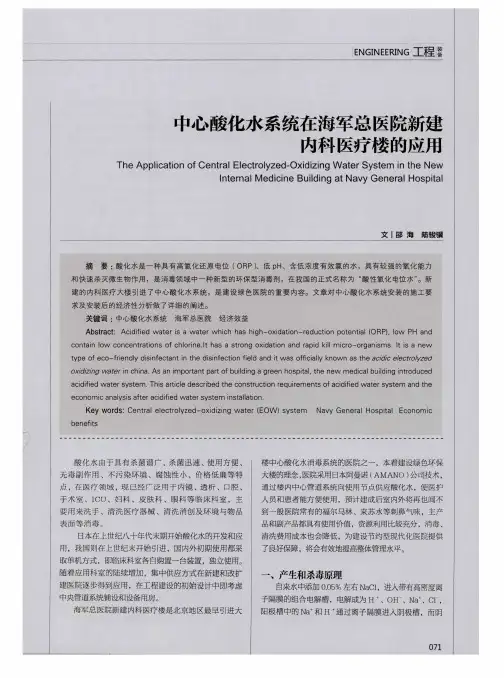

2003/12/17 eG B q P i f X GV P SSq e w P P Va Pq r Pz RK nq (electrolyzed oxidizing water, EO water; strongly acidic electrolyzed water, SAEW; electrolyzed strong acid aqueous solution, ESAAS)¡A OH q A pH2¡6q (oxidation reduction potential, ORP) ¬ +1,000 mV H W A t Sq W r A p u P u Ay H P H E A P A Oe EO water s P A pEO water A i to E A P r E E A WW P q EO water i aP P V H u u A e w PP V n t A q z R ru 3.8% P2% Dialox A z R s yi H z D g q w10 sec Ad x r s A t A H PuAlbrich, J. M. and Hurst, J. K. 1982. Oxidative inactivation of Escherichia coli by hypochlorous acid: rates and differentiation of respiratory from other reaction sites. FEBS Lett. 144: 157-161.Axon, A. J. R. 1991. Endoscopy and disinfection. Summary recommendation. J. Gastroenterol. Hepatol. 6: 23-24.Bronowicki, J. P., Venard, V. and Botte, C. 1997. Patient-to-patient transmission of hepatitis C virus during colonoscopy. N. Eng. J. Med. 337: 237-240.Cook, N. 1998. Methicillin-resistant Staphylococcus aureus versus the burn patient. Burns 24; 91-98.Cowan, R. E., Manning, A. P. and Ayliffe, G. A. J. 1993. Aldehyde disinfectants and health in endoscopy units. Gut. 34:1641-1645.Demmy, T. L., Park, S. B., Liebler, G. A., Burkholder, J. A., Maher, T. D. and Benckart, D. H. 1990. Recent experience with major sternal wound complications. Ann. Thorac. Surg. 49: 458-462.Durante, L., Zulty, J. C., Israel, E., Powers, P. J., Russell, R. G., Qizilbash, A. H. and Morris, J. G. 1992. Investigation of an outbreak of bloody diarrhea: association with endoscopy cleaning solution and demonstration of lesions in an animal model. Am. J. Med. 92: 476-480.Foss, D. and Monagan, D. A. 1992. A national survey of physicians’ and nurses’ attitudes toward endoscope cleaning and the potential for cross-infection. Gastroenterol. Nurs. 15: 59-65.Fuchs, P. C., Kopp, J., Häfner, H., Kleiner, U. and Pallua, N. 2002. MRSA—retrospective analysis of an outbreak in the burn centre Aachen.Burns 28; 575–578Hayashi, H., Kumon, K., Yahagi, N., Haruna, M. and Watanabe, Y. 1997. Successful treatment of mediastinitis after cardiovascular surgery using electrolyzed strong acid aqueous solution. Artif. Organs 21: 39-42.Hung, Y. C., Kim, C. Ezeike, G. O. I., and Lin, C. S. 2000. Acidic electrolyzed (EO) water and its antimicrobial effect. American Chem. Soc., 2000 Annual Meeting in Chicago, I L.Inoue, Y., Endo, S., Kondo, K., Ito, H., Omori, H. and Saito, K. 1997. Trial of electrolyzed strong acid aqueous solution lavage in the treatment of peritonitis and intraperitoneal abscess. Artif. Organs 21: 28-31.Jette, L. P., Ringuette, L. and Ishak, M. 1995. Evaluation of three glutaraldehyde-based disinfectants used in endoscopy. J. Hosp. Infect. 30: 295-203.Kernacki, K. A. and Berk, R. S. 1995. Characterization and arachidonic acid metabolism and the polymorphonuclear leukocyte response in mice infected intracorneally with Pseudomonas aeruginosa. Invest. Ophthalmol. Vis. Sci. 36: 16-23.Kjolseth, D., Frank, J. M., Barker, J. H., Anderson, G. L., Rosenthal, A. I., Acland, R. D., Schuschke, D., Campbell, F. R., Tobin, G. R. and Weiner, L. J. 1994. Comparison of the effects of commonly used wound agents on epithelialization and neovascularization. J. Am. Coll. Surg. 179: 305-312.Kozol, R. A. and Gillies, C. 1988. Effects of sodium hypochlorite (Dakin’s solution) on cells of the wound module. Arch. Surg. 123: 420-423. Matsumura, H., Yoshizawa, N., Kimura, T., Watanabe, K., Gibran, N. S. and Engrav, L. H. 1997. A burn wound healing model in the hairless descendant of the Mexican hairless dog. J. Burn Care Rehabil. 18: 306-312.McPherson, L. L. 1993. Understanding ORP’s in the disinfection process. Water Eng. Manage 11: 29-31.Mine, T. 2003. Cleaning and disinfection in gastrointestinal endoscopy. Dig. Endosc. 15: 76-77.Morita, C., Sano, K., Morimatsu, S., Kiura, H., Goto, T., Kohno, T., Hong, W., Miyoshi, H., Iwasawa, A., Nakamura, Y., Tagawa, M., Yokosuka, O., Saisho, H., Maeda, T. and Katsuoka, Y. 2000. Disinfection potential of electrolyzed solutions containing sodium chloride at low concentrations. J. Virol. Methods 85: 163-174.Nakae, H. and Inaba, H. 2000a. Effectiveness of electrolyzed oxidized water irrigation in a burn- wound infection model. J. Trauma 49: 511-514. Nakae, H. and Inaba, H. 2000b. Electrolyzed strong acid aqueous solution irrigation promotes wound helaing in a burn wound model. Artif.Organs 24: 544-546.Rath, T. and Meissl, G. 1988. Induction of hyperthyroidism in burn patients treated topically with povidone-iodine. Burns 14: 320-322.Sakurai, Y., Nakatsu, M., Sato, Y. and Sato, K. 2003. Endoscope contamination from HBV- and HCV- positive patients and evaluation of a cleaning/ disinfecting method using strongly acidic electrolyzed water. Dig. Endosc. 15: 19-24.Sakurai, Y., Ogoshi, K., Kaku, M. and Kobayashi, I. 2002. Strongly acidic electrolyzed water: valuable disinfectant of endoscopes. Dig. Endosc. 14: 61-66.Sekiya, S., Ohmori, K. and Harii, K. 1997. Treatment of infectious skin defects or ulcers with electrolyzed strong acid aqueous solution. Artif.Organs 21: 32-38.Shelanski, H. A. and Shelanski, M. V. 1956. PVP-iodine: history, toxicity and therapeutic uses. J. Int. Coll. Surg. 25: 727-734.Shigeto, S., Matsumoto, K., Yaguchi, H., Okuda, T., Miyajima, S., Negi, A., Shimazaki, J. and Tsubota, K. 2000. Acidic electrolyzed water in the disinfection of the ocular surface. Exp. Eye Res. 70: 1-6.Shimizu, Y. and Sugawara, H. 1996. Virucidal and bactericidal effects of electrolyzed oxidizing water: comparison of disinfectant effect with electrolyzed oxidizing water and hypochlorous acid. Jpn. J. Oral Biol. 38: 564-571.St.-Clair, M. B. Bermudez, E., Gross, E. A., Butterworth, B. E. and Recio, L., 1991. Evaluation of the genotoxic potential of glutaraldehyde.Environ. Mol. Mutagen. 18: 113-119.Sun, H. W., Feigal, R. J. and Messer, H. H. 1990. Cytoxicity of glutaraldehyde and formaldehyde in relation to time of exposure and concentration.Pediatr. Dent. 12: 303-307.Tanaka, N., Fujisawa, T., Daimon, T., Fujiwara, K., Tanaka, N., Yamamoto, M. and Abe, T. 1999. The effect of electrolyzed strong acid aqueous solution on hemodialysis equipment. Artif. Organs 23: 1055-1062.Tanaka, N., Fujisawa, T., Daimon, T., Fujiwara, K., Yamamoto, M. and Abe, T. 2000. The use of electrolyzed solutions for the cleaning and disinfecting of dialyzers. Artif. Organs 24: 921-928.Tanaka, N., Tanaka, N., Fujisawa, T., Daimon, T., Fujiwara, K., Yamamoto, M. and Abe, T. 1999. The cleaning and disinfecting of hemodialysis equipment using electrolyzed strong acid aqueous solution. Artif. Organs 23: 303-309.Xin, H., Zheng, Y. J., Hajimen, N. and Han, Z. G. 2003. Effect of electrolyzed oxidizing water and hydrocolloid occlusive dressing on excised burn-wounds in rats. J. Trauma. 43: 781-787.Yahagi, N., Kono, M., Kitahara, M., Ohmura, A. and Sumita, O. 2000. Effect of electrolyzed water on wound healing. Artif. Organs 24: 984-987. Zamora, J. L. 1986. Chemical and microbiologic characteristics and toxicity of povidone-iodine solutions. Am. J. Surg. 151: 400-406.Kim, C., Hung, Y. C. and Brachett, R. E. 2000a. Efficacy of electrolyzed oxidizing (EO) and chemically modified water on different types of foodborne pathogens. Int. J. Food Microbiol. 61: 199-207.Kim, C., Hung, Y. C. and Brachett, R. E. 2000b. Roles of oxidation -reduction potential in electrolyzed oxidizing and chemically modified water for inactivation of food-related pathogens. J. Food Prot. 63: 19-24.Wach, F., Hein, R., Adelmann-Grill, B. C. and Kreig, T. 1987. Inhibition of fibroblast chemotaxis by superoxide dismutase. Eur. J. Cell Biol. 44: 124-127.Murrell, G. A., Francis, M. J. and Bromley, L. 1990. Modulation of fibroblast proliferation by oxygen free radicals. Biochem. J. 265: 659-665. Nicotera, T. M., Privalle, C., wang, T. C., Oshimura, M. and Barrett, J. C. 1994. Differential proliferative responses of Syrian hamster embryo fibroblasts to paraquat-generated superoxide radicals depending on tumor suppressor gene function. Cancer Res. 53: 3884-3888. Subirade, I., Fernandez, Y., Periquet, A. and Mitjavila, S. 1995. Catechin protection of 3T3 Swiss fibroblasts in culyure under oxidative stress. Bio.Trace Elem. Res. 47: 313-319.Shimmura, S., Matsumoto, K., Yaguchi, H., Okuda, T., Miyajima, S., Negi, A., Shimazaki, J. and Tsubota, K. 2000. Acidic electrolyzed water in the disinfection of the ocular surface. Exp. Eye. Res. 70: 1-6.。
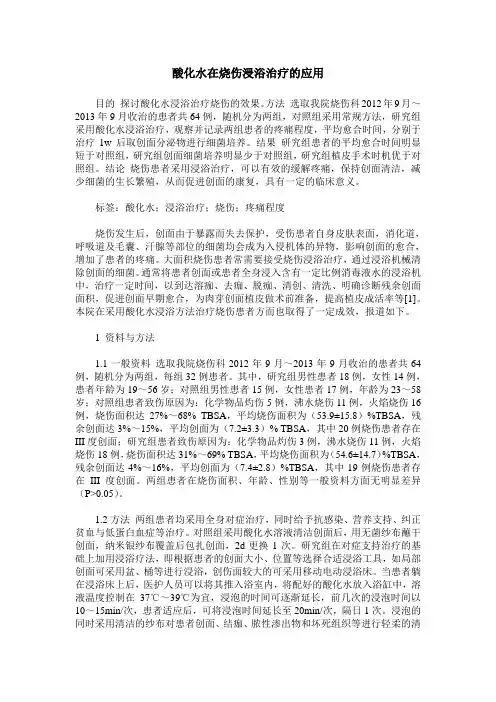
酸化水在烧伤浸浴治疗的应用目的探讨酸化水浸浴治疗烧伤的效果。
方法选取我院烧伤科2012年9月~2013年9月收治的患者共64例,随机分为两组,对照组采用常规方法,研究组采用酸化水浸浴治疗,观察并记录两组患者的疼痛程度,平均愈合时间,分别于治疗1w后取创面分泌物进行细菌培养。
结果研究组患者的平均愈合时间明显短于对照组,研究组创面细菌培养明显少于对照组,研究组植皮手术时机优于对照组。
结论烧伤患者采用浸浴治疗,可以有效的缓解疼痛,保持创面清洁,减少细菌的生长繁殖,从而促进创面的康复,具有一定的临床意义。
标签:酸化水;浸浴治疗;烧伤;疼痛程度烧伤发生后,创面由于暴露而失去保护,受伤患者自身皮肤表面,消化道,呼吸道及毛囊、汗腺等部位的细菌均会成为入侵机体的异物,影响创面的愈合,增加了患者的疼痛。
大面积烧伤患者常需要接受烧伤浸浴治疗,通过浸浴机械清除创面的细菌。
通常将患者创面或患者全身浸入含有一定比例消毒液水的浸浴机中,治疗一定时间,以到达溶痂、去痂、脱痂、清创、清洗、明确诊断残余创面面积,促进创面早期愈合,为肉芽创面植皮做术前准备,提高植皮成活率等[1]。
本院在采用酸化水浸浴方法治疗烧伤患者方而也取得了一定成效,报道如下。
1 资料与方法1.1一般资料选取我院烧伤科2012年9月~2013年9月收治的患者共64例,随机分为两组,每组32例患者。
其中,研究组男性患者18例,女性14例,患者年龄为19~56岁;对照组男性患者15例,女性患者17例,年龄为23~58岁;对照组患者致伤原因为:化学物品灼伤5例,沸水烧伤11例,火焰烧伤16例,烧伤面积达27%~68% TBSA,平均烧伤面积为(53.9±15.8)%TBSA,残余创面达3%~15%,平均创面为(7.2±3.3)% TBSA,其中20例烧伤患者存在III度创面;研究组患者致伤原因为:化学物品灼伤3例,沸水烧伤11例,火焰烧伤18例,烧伤面积达31%~69% TBSA,平均烧伤面积为(54.6±14.7)%TBSA,残余创面达4%~16%,平均创面为(7.4±2.8)%TBSA,其中19例烧伤患者存在III度创面。

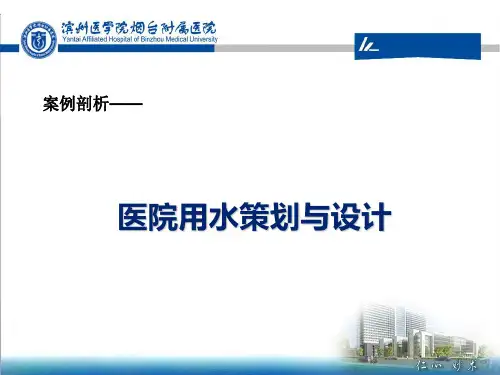
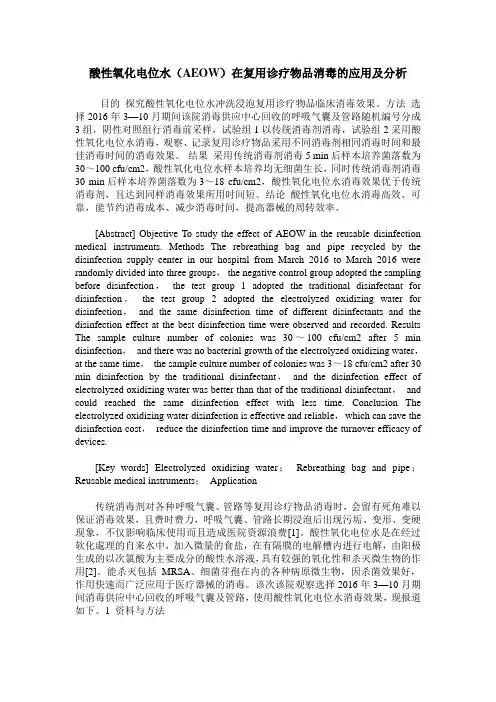
酸性氧化电位水(AEOW)在复用诊疗物品消毒的应用及分析目的探究酸性氧化电位水冲洗浸泡复用诊疗物品临床消毒效果。
方法选择2016年3—10月期间该院消毒供应中心回收的呼吸气囊及管路随机编号分成3组,阴性对照组行消毒前采样,试验组1以传统消毒剂消毒,试验组2采用酸性氧化电位水消毒,观察、记录复用诊疗物品采用不同消毒剂相同消毒时间和最佳消毒时间的消毒效果。
结果采用传统消毒剂消毒5 min后样本培养菌落数为30~100 cfu/cm2,酸性氧化电位水样本培养均无细菌生长,同时传统消毒剂消毒30 min后样本培养菌落数为3~18 cfu/cm2,酸性氧化电位水消毒效果优于传统消毒剂,且达到同样消毒效果所用时间短。
结论酸性氧化电位水消毒高效、可靠,能节约消毒成本、减少消毒时间,提高器械的周转效率。
[Abstract] Objective To study the effect of AEOW in the reusable disinfection medical instruments. Methods The rebreathing bag and pipe recycled by the disinfection supply center in our hospital from March 2016 to March 2016 were randomly divided into three groups,the negative control group adopted the sampling before disinfection,the test group 1 adopted the traditional disinfectant for disinfection,the test group 2 adopted the electrolyzed oxidizing water for disinfection,and the same disinfection time of different disinfectants and the disinfection effect at the best disinfection time were observed and recorded. Results The sample culture number of colonies was 30~100 cfu/cm2 after 5 min disinfection,and there was no bacterial growth of the electrolyzed oxidizing water,at the same time,the sample culture number of colonies was 3~18 cfu/cm2 after 30 min disinfection by the traditional disinfectant,and the disinfection effect of electrolyzed oxidizing water was better than that of the traditional disinfectant,and could reached the same disinfection effect with less time. Conclusion The electrolyzed oxidizing water disinfection is effective and reliable,which can save the disinfection cost,reduce the disinfection time and improve the turnover efficacy of devices.[Key words] Electrolyzed oxidizing water;Rebreathing bag and pipe;Reusable medical instruments;Application传统消毒剂对各种呼吸气囊、管路等复用诊疗物品消毒时,会留有死角难以保证消毒效果,且费时费力,呼吸气囊、管路长期浸泡后出现污垢、变形、变硬现象,不仅影响临床使用而且造成医院资源浪费[1]。
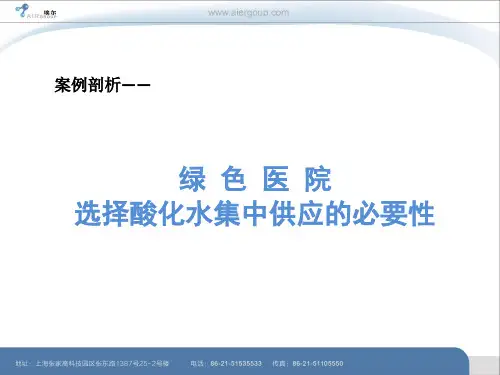
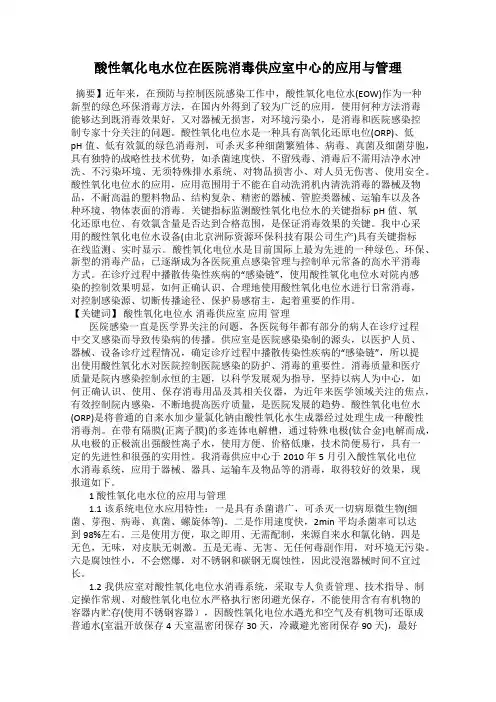
酸性氧化电水位在医院消毒供应室中心的应用与管理摘要】近年来,在预防与控制医院感染工作中,酸性氧化电位水(EOW)作为一种新型的绿色环保消毒方法,在国内外得到了较为广泛的应用,使用何种方法消毒能够达到既消毒效果好,又对器械无损害,对环境污染小,是消毒和医院感染控制专家十分关注的问题。
酸性氧化电位水是一种具有高氧化还原电位(ORP)、低pH值、低有效氯的绿色消毒剂,可杀灭多种细菌繁殖体、病毒、真菌及细菌芽胞,具有独特的战略性技术优势,如杀菌速度快、不留残毒、消毒后不需用洁净水冲洗、不污染环境、无须特殊排水系统、对物品损害小、对人员无伤害、使用安全。
酸性氧化电位水的应用,应用范围用于不能在自动洗消机内清洗消毒的器械及物品,不耐高温的塑料物品、结构复杂、精密的器械、管腔类器械、运输车以及各种环境、物体表面的消毒。
关键指标监测酸性氧化电位水的关键指标pH值、氧化还原电位、有效氯含量是否达到合格范围,是保证消毒效果的关键。
我中心采用的酸性氧化电位水设备(由北京洲际资源环保科技有限公司生产)具有关键指标在线监测、实时显示。
酸性氧化电位水是目前国际上最为先进的一种绿色、环保、新型的消毒产品,已逐渐成为各医院重点感染管理与控制单元常备的高水平消毒方式。
在诊疗过程中播散传染性疾病的“感染链”,使用酸性氧化电位水对院内感染的控制效果明显,如何正确认识、合理地使用酸性氧化电位水进行日常消毒,对控制感染源、切断传播途径、保护易感宿主,起着重要的作用。
【关键词】酸性氧化电位水消毒供应室应用管理医院感染一直是医学界关注的问题,各医院每年都有部分的病人在诊疗过程中交叉感染而导致传染病的传播。
供应室是医院感染染制的源头,以医护人员、器械、设备诊疗过程情况,确定诊疗过程中播散传染性疾病的“感染链”,所以提出使用酸性氧化水对医院控制医院感染的防护、消毒的重要性。
消毒质量和医疗质量是院内感染控制永恒的主题,以科学发展观为指导,坚持以病人为中心,如何正确认识、使用、保存消毒用品及其相关仪器,为近年来医学领域关注的焦点,有效控制院内感染,不断地提高医疗质量,是医院发展的趋势。
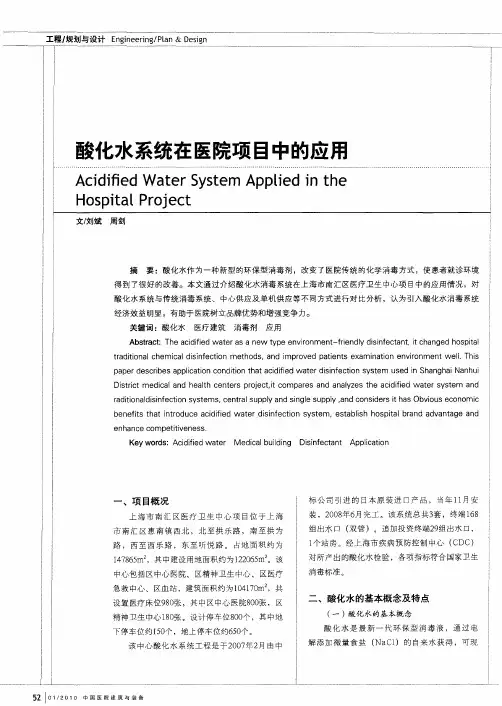

酸化水系统在医院项目中的应用Document serial number【KKGB-LBS98YT-BS8CB-BSUT-BST108】酸化水系统在医院项目中的应用像类似我院自哪年什么引进多少台这种的也不要,然后再加一些关于维修的步骤,刚刚加的那个是安装的处理方式,多加一些自己的总结或者建议,资料方法的1.1写国内现状1.2写国外现状然后做一些对比,结果方面的加一些跟以前的对比,谢谢了【摘要】目的:分析酸化水系统应用于院内消毒的价值。
方法:分析投入酸化水系统后,经济收益以及实际效果。
结果:自投入使用酸化水系统以来,运营成本在一定程度上降低,全面提升了工作效率。
酸化水已经替代了当前在医院90%的消毒剂。
酸化水更具环保性。
经1年的运行,不管是在管理还是水质提升方面,均得到了极大改善。
和以往相比,经济以及社会效益也得到了显着提升。
院内感染控制迈入了新的台阶,全面提升院内硬件设施水平,树立医院的良好形象,确保患者就医环境和在当地医疗行业中的地位。
投资效益高,短时间内可以回收成本。
结论:在院内配设酸化水消毒工程系统,可全面改变既往化学消毒方式,可为患者和医护人员提供良好的就医环境和工作环境,在一定程度上改善院内硬件设施条件,提升经济以及社会效益,树立医院品牌,提升综合竞争力,值得进一步推广。
【关键词】酸化水系统;医院消毒;效果分析酸化水是一种新型无公害消毒剂,使用酸化水对医院项目实施消毒,可全面改善患者的就医环境,可提升院内品牌优势,增加核心竞争能力【1】。
就消毒原理来看,主要为:自来水通过酸化水转变装置,经电离分解之后可形成两种不同类型的水,一种是碱性水,其具备较强清洁能力;另外一种是酸性水,具有良好的杀菌效果【2】。
分离好的酸性水贮藏于水槽中,后经过院内中心管路体系,配送至院内各个使用点,以供使用。
结合实际情况,本文现就酸化水系统在医院项目中的应用价值进行简要分析,现报告如下。
1.资料于方法1.1一般资料我院各个科室共有先进化医疗设备,近几年,我院消毒中心内放设了酸化水系统,病房大楼共计十余万平方米,共计3个酸化水供应中心。
酸性氧化电位水在医院的应用酸性氧化电位水是一种具有高氧化电位、低pH值和显著杀菌能力的电离水,因其高效、广谱、安全、环保而越来越得到大家的认可。
本文就酸性氧化电位水的制备、性能以及在医院领域的应用进行综述。
酸性氧化电位水(Electrolyzed oxidizing water,EOW),也称强酸性电位水,是在普通自然原水(如自来水等)中加入少量氯化钠(低于0.1%),经过特殊的离子交换隔膜电解装置进行微电解处理,在阳极区产生的具有高氧化还原电位(Oxidation reduction potential,ORP)和低pH值的特殊离子水。
酸性氧化电位水的应用可以追溯到上世纪80年代的日本,我国在90年代开始引进这一技术,因其具备显著的杀菌效果、较低廉的成本以及对环境无污染而广泛应用于医疗、食品、畜产、农业领等域[1-4],本文主要探讨酸性氧化电位水在医院的应用。
1 EOW的制备EOW是将浓度1,参照卫生部消毒技术规范,判定为消毒合格。
3.2 医疗器械消毒酸性氧化电位水因其杀菌效果好、作用快速而广泛应用于医疗器械的消毒[16]。
徐世兰等[17]连续15 d在门诊胃镜室随机抽取52例患者使用后的胃镜,在常规清洗后用酸性氧化电位水流动浸泡消毒3 min,并在消毒前后胃镜的表面、胃镜腔内采样进行细菌培养,观察酸性氧化电位水的消毒杀菌效果,结果显示,对污染胃镜表面菌落的平均杀菌率为99.95%,对污染胃镜腔内菌落的平均杀菌率为99.93%,符合国家消毒卫生标准。
杨怀等[18]随机抽取门诊和住院患者做无痛胃镜和肠镜检查污染前后胃、肠镜,比较酸性氧化电位水(EOW)和戊二醛用于临床无痛胃镜和肠镜消毒的结果、对人体的危害及稳定性,结果显示,EOW 3~5min可杀灭胃、肠镜检查中的病原菌,戊二醛>10 min 才能杀灭常见的病原菌,EOW对人体无过敏反应和黏膜刺激,但稳定性差,戊二醛对人体均有黏膜刺激和个别过敏反应。
酸性氧化电位水在医院的应用邓春圣;吕双丛;郝晓菁【期刊名称】《中国医学创新》【年(卷),期】2015(12)25【摘要】酸性氧化电位水是一种具有高氧化电位、低pH值和显著杀菌能力的电离水,因其高效、广谱、安全、环保而越来越得到大家的认可。
本文就酸性氧化电位水的制备、性能以及在医院领域的应用进行综述。
%Acidic electrolyzed oxidizing water is ionized water with a high oxidation potential, low pH value and significant bactericidal capability, is increasingly recognized by people because of its higefficiency, broad-spectrum, safety, environmental protection. Preparation, properties and recent application in the field of hospital of EOW are reviewed in this paper.【总页数】4页(P150-152,153)【作者】邓春圣;吕双丛;郝晓菁【作者单位】解放军第264医院山西太原 030001;解放军第264医院山西太原030001;解放军第264医院山西太原 030001【正文语种】中文【相关文献】1.酸性氧化电位水在医院消毒供应中心的应用 [J], 刘元峰2.酸性氧化电位水在口腔医院消毒供应中心的应用 [J], 岑琼;陈颖超;刘琳3.酸性氧化电位水在口腔医院消毒供应中心的应用 [J], 岑琼;陈颖超;刘琳;4.酸性氧化电位水在野战方舱医院感染控制中的应用 [J], 罗廷刚;刘亚男;王晨宇;赵丽君;樊毫军;武周炜;石莹5.酸性氧化电位水在预防控制口腔科医院感染中的应用 [J], 梁玉霞;梁君;周政因版权原因,仅展示原文概要,查看原文内容请购买。
酸化水作为一种新型的环保型消毒剂,改变了医院传统的化学消毒方式,使患者就诊环境得到了很好的改善。
我们假定一个项目占地面积约为147865m2,其中建设用地面积约为122065m2。
该项目包括区中心医院、区精神卫生中心、区医疗急救中心、区血站,建筑面积约为104170m2,共设置医疗床位980张,其中区中心医院800张,区精神卫生中心180张。
设计停车位800辆,其中地下停车位约150辆,地上停车位约650辆。
下面针对上海埃尔大楼使用中心酸化水的经济性分析:中心酸化水成本主要包括专用电解剂;水费;电费;维护费等构成计算依据如下:(以下单价只是假设的)成本,元/每升专用氯化钠价格为12元/千克。
①软水用盐量:1千克/每次再生,再生周期按1天,按日使用量为3000升计算,则每生成1升酸化水,盐消耗量为:1÷(3000×1)=3.3×10-4千克②酸化水主机用盐量:10×10-4千克/每生成1升酸化水12×(3.3+10)×10-4=0.016自来水水费每生成1升酸化水(同时生成1升碱性水)自来水水费按4元/吨(1000升)计算4÷1000×2=0.008按工业用水电费酸化水系统工作时耗电主要有酸化水主机、软水器及自动终端构成,总计约0.6kw。
酸化水装置生成量为:2升/分钟(120L/h)。
电费按1.2元/度计算1.2×0.6÷120=0.006设备维护费用设备维护费用(主要是更换电解槽费用):26000元/年(按4500小时)26000÷4500÷120=0.048合计0.016+0.008+0.006+0.048=0.078(每升酸化水成本约0.078元)根据上述酸化水经济计算方式来推算。
酸性氧化电位水(AEOW)在复用诊疗物品消毒的应用及分析作者:王元芝李燕范玉红潘庆华来源:《中外医疗》2017年第06期[摘要] 目的探究酸性氧化电位水冲洗浸泡复用诊疗物品临床消毒效果。
方法选择2016年3—10月期间该院消毒供应中心回收的呼吸气囊及管路随机编号分成3组,阴性对照组行消毒前采样,试验组1以传统消毒剂消毒,试验组2采用酸性氧化电位水消毒,观察、记录复用诊疗物品采用不同消毒剂相同消毒时间和最佳消毒时间的消毒效果。
结果采用传统消毒剂消毒5 min后样本培养菌落数为30~100 cfu/cm2,酸性氧化电位水样本培养均无细菌生长,同时传统消毒剂消毒30 min后样本培养菌落数为3~18 cfu/cm2,酸性氧化电位水消毒效果优于传统消毒剂,且达到同样消毒效果所用时间短。
结论酸性氧化电位水消毒高效、可靠,能节约消毒成本、减少消毒时间,提高器械的周转效率。
[关键词] 酸性氧化电位水;呼吸气囊、管路;复用诊疗物品;应用[中图分类号] R5 [文献标识码] A [文章编号] 1674-0742(2017)02(c)-0160-03Application and Analysis of AEOW in the Reusable Disinfection Medical InstrumentsWANG Yuan-zhi1, LI Yan2, FAN Yu-hong1, PAN Qing-hua11.Disinfection Supply Center, Binzhou Central Hospital, Binzhou, Shandong Province,251700 China;2.Infection Management Section,Binzhou Central Hospital, Binzhou, Shandong Province, 251700 China[Abstract] Objective To study the effect of AEOW in the reusable disinfection medical instruments. Methods The rebreathing bag and pipe recycled by the disinfection supply center in our hospital from March 2016 to March 2016 were randomly divided into three groups, the negative control group adopted the sampling before disinfection, the test group 1 adopted the traditional disinfectant for disinfection, the test group 2 adopted the electrolyzed oxidizing water fordisinfection, and the same disinfection time of different disinfectants and the disinfection effect at the best disinfection time were observed and recorded. Results The sample culture number of colonies was 30~100 cfu/cm2 after 5 min disinfection, and there was no bacterial growth of the electrolyzed oxidizing water, at the same time, the sample culture number of colonies was 3~18 cfu/cm2 after 30 min disinfection by the traditional disinfectant, and the disinfection effect of electrolyzed oxidizing water was better than that of the traditional disinfectant, and could reached the same disinfection effect with less time. Conclusion The electrolyzed oxidizing water disinfection is effective and reliable, which can save the disinfection cost, reduce the disinfection time and improve the turnover efficacy of devices.[Key words] Electrolyzed oxidizing water; Rebreathing bag and pipe; Reusable medical instruments; Application传统消毒剂对各种呼吸气囊、管路等复用诊疗物品消毒时,会留有死角难以保证消毒效果,且费时费力,呼吸气囊、管路长期浸泡后出现污垢、变形、变硬现象,不仅影响临床使用而且造成医院资源浪费[1]。
医院实验室用水管理探讨在医院中,实验室是一个重要的部门,它承担着临床诊断、检测和研究的任务。
实验室工作离不开水,它是实验室中必不可少的资源之一。
水的质量和管理对实验室的正常运作至关重要。
因此,医院实验室用水管理成为一项需要认真对待的任务。
本文将探讨医院实验室用水管理的重要性以及相应的管理策略。
一、医院实验室用水管理的重要性医院实验室用水的管理对保证实验室工作的正常进行具有重要意义。
首先,水的质量直接影响到实验结果的准确性和可靠性。
在许多实验中,水是作为试剂或溶剂使用的,水质的好坏直接决定了实验结果的准确程度。
其次,水的不合格可能对实验仪器设备产生损害。
特别是高灵敏度的仪器,如高性能液相色谱仪(HPLC)、气相色谱仪(GC)等,对水的纯度要求非常高,以防止污染物对仪器的损害。
此外,医院实验室用水对保障医院公共卫生和员工健康至关重要,只有水质安全可靠,才能确保卫生和健康环境。
二、医院实验室用水管理的策略为了保证医院实验室用水的质量和管理,以下几个方面的策略值得考虑:1.水的采购和供应医院实验室应选择可靠的供应商,并签订正式合同,明确供应商应提供的水质标准、供应周期和水量要求等。
供应商应定期提供水质检测报告,确保水的质量符合要求。
此外,医院应建立定期巡检的机制,确保供水设备的正常运行,及时发现并修复水质问题。
2.水质监测和检测医院实验室应建立水质检测的标准和频率。
对于重要实验项目和流程,应加强对水质的监测和检测,确保水质稳定和安全。
医院实验室可以采用相关的水质检测设备,并培训专业人员进行操作和维护。
3.水质处理和纯化技术医院实验室应根据实验需求选择合适的水质处理和纯化技术。
常见的水质处理技术包括反渗透、阳离子交换、紫外线消毒等。
医院应根据实验室使用的具体要求,进行技术选择和设备配置,并定期维护和更换设备,以确保水的质量达标。
4.员工培训和意识提升医院实验室应定期组织员工培训,提高员工对水质管理的认识和意识。
酸化水系统在医院项目中的应用
刘斌;周剑
【期刊名称】《中国医院建筑与装备》
【年(卷),期】2010(000)001
【摘要】酸化水作为一种新型的环保型消毒剂,改变了医院传统的化学消毒方式,使患者就诊环境得到了很好的改善.本文通过介绍酸化水消毒系统在上海市南汇区医疗卫生中心项目中的应用情况,对酸化水系统与传统消毒系统、中心供应及单机供应等不同方式进行对比分析,认为引入酸化水消毒系统经济效益明显,有助于医院树立品牌优势和增强竞争力.
【总页数】3页(P52-54)
【作者】刘斌;周剑
【作者单位】上海上咨建设工程咨询有限公司,上海,201906;上海上咨建设工程咨询有限公司,上海,201906
【正文语种】中文
【相关文献】
1.中心酸化水系统在海军总医院新建内科医疗楼的应用 [J], 邵海;陆骏骥
2.水解酸化池动力装置配水式布水系统在工程中的研究及应用 [J], 刘苑丽
3.空气源热泵集中热水系统在康复医院项目中的应用及经济性分析 [J], 周鹏瑞
4.空气源热泵集中热水系统在康复医院项目中的应用及经济性分析 [J], 周鹏瑞
5.济南某医院的医务科曾干事来信询问:在医疗纠纷赔偿的项目中,有一项是残疾赔偿金,什么样的情况赔偿这一项?应该如何赔偿? [J],
因版权原因,仅展示原文概要,查看原文内容请购买。